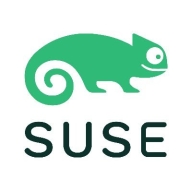


SUSE Manager and AWS CloudFormation operate in the domain of IT and cloud management. AWS CloudFormation often has the upper hand due to its extensive feature set tailored to comprehensive cloud architecture requirements.
Features: SUSE Manager offers centralized administration, automated patch management, and compliance auditing specifically for Linux systems. AWS CloudFormation highlights include its ability to model, provision, and manage AWS infrastructure using code, infrastructure management as code, and resource automation.
Room for Improvement: SUSE Manager could expand support for more operating systems, improve user interface design, and enhance integration capabilities with other tools. AWS CloudFormation might benefit from simplifying its initial learning curve, enhancing parameter handling in templates, and integrating more user-friendly documentation.
Ease of Deployment and Customer Service: SUSE Manager is deployed easily across various infrastructure setups and prioritizes customer service focused on system management queries. AWS CloudFormation requires some familiarity with Infrastructure as Code but offers seamless integration within AWS, with customer service focusing on cloud infrastructure management.
Pricing and ROI: SUSE Manager provides favorable ROI and competitive pricing for Linux server management, especially for initial setup costs. AWS CloudFormation ties its pricing to AWS service usage, presenting higher upfront costs, but delivers significant ROI benefits for expansive cloud environments.
Everything we've gained from it makes my job easier day after day, and I see value in it as an engineer.
Microsoft Intune not only saves costs by reducing the number of personnel needed but also offers a comprehensive solution for managing laptops, applications, security, individual access, and enrollment.
Importantly, when someone leaves the company, it helps protect document access on their devices.
When a support ticket is submitted, it directly reaches someone with Intune support expertise.
When I contacted Microsoft, they had the same expertise, if not more, which is phenomenal because I felt heard and my problem was solved.
Sometimes, the support provided is excellent, and the representative is knowledgeable, while other times, the service needs improvement.
While this might be acceptable for some, it can be lengthy depending on the urgency of the issue.
Free support for AWS CloudFormation is not provided, and while some support is understandable due to its complexity, assistance for service-related issues should be accessible without a cost.
Generally, the support is good, but there are instances where the support team seems disinterested in solving complex problems.
The scalability of Microsoft Intune is ten out of ten.
Ideally, we want to automatically segregate devices based on user properties like primary use, but currently, dynamic groups seem limited to device properties.
It supports organizations with 200 endpoints and those with more than 15,000 endpoints.
Splitting CloudFormation into multiple formations results in changes to resources like API gateway URLs and Cognito pools, which causes issues, especially when trying to maintain consistency across resources.
Adjusting capacity and functionality is a fundamental use.
We have not experienced downtime, bugs, or glitches.
It appears Microsoft Intune undergoes changes without informing customers.
Microsoft Intune has been very stable.
It has been reliable and efficient in all my deployments.
Data loss can occur when splitting or scaling applications due to changes in resources.
It's a service that has been around for years, and it handles large complex deployments and updates with very good consistency.
The stability of SUSE Manager is fine.
Features like unlocking devices sometimes fail, and the support offered for other operating systems is insufficient.
There are communication issues, so you might start working with a feature without knowing if it will be deprecated six months from now.
Many third-party companies offer single-pane-of-glass reporting that shows you what your update environment looks like, how your patch is doing, application status, etc., but Intune's reporting is not intuitive.
It presents challenges for users unfamiliar with coding, posing as a barrier to fully utilizing CloudFormation.
Creating microservices and connecting multiple APIs into a single API gateway can be challenging; documentation should address specific needs.
Managing the correct order of resource creation and some updates can be tricky, especially with interdependent resources.
A better description of the initial setup process could enhance user experience.
Features that can be helpful in disaster recovery.
From an integration perspective, it is difficult to integrate with Jira or any ticketing tool, which is challenging.
Introductory professional services, like a fast-track service, were included with our E5 membership, and there have been no additional costs.
The Intune suite and add-ons, such as batch management and remote help, are costly.
It costs approximately forty euros per user per month.
AWS CloudFormation is free.
Intune excels in configuration and compliance management for Windows 10, ensuring devices receive timely updates and adhere to organizational standards.
Dynamic groups allow us to set conditions for automatic membership, eliminating the need for user intervention or manual review and ensuring a seamless workflow.
Windows Autopatch is the most valuable because it removes the burden of patch management.
I can see the entire infrastructure and its connections through code.
Managing, maintaining, and deploying become easier as it allows the creation of the same resources on multiple accounts, making it efficient for infrastructure management.
It supports more than six or seven Linux flavors, and when compared to other tools such as Satellite, which only supports the Red Hat operating system, SUSE Manager supports Red Hat, Ubuntu, Debian, and some other Linux operating systems for patch management.
SUSE Manager is valuable for managing systems, patching, and utilizing SaltStack connectivity for various installations and other routines.
| Product | Market Share (%) |
|---|---|
| Microsoft Intune | 9.4% |
| AWS CloudFormation | 2.4% |
| SUSE Manager | 3.3% |
| Other | 84.9% |



| Company Size | Count |
|---|---|
| Small Business | 116 |
| Midsize Enterprise | 46 |
| Large Enterprise | 152 |
| Company Size | Count |
|---|---|
| Small Business | 15 |
| Midsize Enterprise | 8 |
| Large Enterprise | 17 |
| Company Size | Count |
|---|---|
| Small Business | 6 |
| Midsize Enterprise | 1 |
| Large Enterprise | 2 |
Microsoft Intune provides centralized management of mobile devices and applications, ensuring security, compliance, and productivity through integration with Microsoft services like Microsoft 365 and Azure Active Directory.
Organizations use Intune for managing mobile devices and applications, enhancing security and compliance across platforms. With features like single sign-on, conditional access, and zero-touch deployment via Autopilot, it facilitates efficient operations. Intune's scalability, easy enrollment, and capabilities such as remote wipe support diverse device management, offering robust data protection and efficient operation. Despite its features, improvement areas include reporting, compatibility with non-Microsoft devices, and better support for macOS and Linux devices.
What are the key features of Microsoft Intune?
What benefits should users look for in reviews?
In industries such as finance, healthcare, and education, Microsoft Intune is implemented to ensure secure and compliant device management. Companies leverage its capabilities to deploy security policies and manage both corporate-owned and BYOD environments, facilitating a unified approach to data protection and compliance.
AWS CloudFormation provides a common language for you to model and provision AWS and third party application resources in your cloud environment. AWS CloudFormation allows you to use programming languages or a simple text file to model and provision, in an automated and secure manner, all the resources needed for your applications across all regions and accounts. This gives you a single source of truth for your AWS and third party resources.
SUSE Manager was designed to help your enterprise DevOps and IT Operations teams reduce complexity and regain control of your IT assets with a single tool to manage Linux systems across a variety of hardware architectures, hypervisors as well as container, IoT and cloud platforms. It automates Linux server and IoT device provisioning, patching and configuration for faster, consistent and repeatable server deployment helping to optimize operations and reduce costs. And with automated monitoring, tracking, auditing and reporting of your systems, VMs, and containers across your development, test and production environments, you can ensure compliance with internal security policies and external regulations.
We monitor all Configuration Management reviews to prevent fraudulent reviews and keep review quality high. We do not post reviews by company employees or direct competitors. We validate each review for authenticity via cross-reference with LinkedIn, and personal follow-up with the reviewer when necessary.